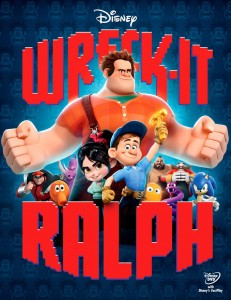The Creation-Fall-Redemption-Restoration story arc of Christianity can be seen in Disney’s animated movie Wreck-It Ralph (2012). This was surprising to me too! In the beginning of the movie, we are introduced to Wreck-It Ralph, who is a good-hearted guy programmed to play the bad guy role of the wrecker in his arcade game—with his large hands, tall stature, and many muscles. He is built to be the perfect wrecker. While Fix-It Felix, the supposed hero (at least of the game), is the good guy who fixes everything and always gets the medal and the cheers. After all, the arcade game is called Fix-It Felix Junior.
Ralph fulfills his role as the wrecker for 30 years without complaint. He is the villain, the bad guy and he is ok with playing that role. But after hours, in the darkness of the arcade, Ralph is ostracized from the rest of his world for his role during game time. Ralph is an outcast living in the dump who longs for the community found in the apartment complex where Felix and the Nicelanders live. Is he good or is he bad? He has an identity crisis, wanting to be Felix, wanting to be the good guy everyone loves, wanting to be the one getting the medal in his game. In Ralph’s frustration he demolishes a cake at the Nicelanders’ party celebrating the games 30th anniversary.
Ralph seeks out comfort for his situation in a local Bad-anon meeting where all the villains in the arcade get together. At the meeting Ralph exclaims, “I don’t want to be the bad guy anymore!” To which another villain responds, “You can’t mess with the program Ralph.” Ralph and the other villains’ chant during the group therapy meeting: “I’m bad and that’s good. I will never be good and that’s not bad. There’s no one I’d rather be than me.”
On his way back to his game, Ralph over hears someone talking about a new game, Hero’s Duty, in which you can earn a gold medal. Ralph immediately equates earning a medal with being a hero and a good guy. So Ralph does what no video game character is ever supposed to do– he goes ‘turbo’ and enters the other game seeking a medal. Of course havoc ensues, especially because Ralph is by nature and body type only a wrecker of things. Ralph gets the medal, but ends up in another game, Sugar Rush. And unbeknownst to him an enemy cy-bug from Hero’s Duty has tagged along with him—essentially going turbo as well. And upon landing in Sugar Rush Ralph loses his hard-won medal to a little girl.
We come to find out that the girl, Vanellope von Schweetz, is also seen as an undesirable, like Ralph. And like Ralph she is ostracized from her community— him for his bad guy wrecker role and her for her glitch. When he gets emotional he wrecks things. And when she gets emotional she glitches. He lives in a dump and she lives in an unfinished bonus level inside a mountain. Both live alone amidst refuse and unwanted things. Ralph wants to earn a medal to prove his worth and Vanellope wants to win a race to prove her worth.
Yet, ironically, in pursuing his dream of winning a hero’s medal, which to him equals good-guy status, Ralph has endangered his game and his community… and maybe even the whole arcade. While Ralph is gone an arcade gamer tries to play his game, but nothing happens. Felix has nothing to fix because Ralph hasn’t wrecked the building. The arcade gamer and the manager of the arcade assume the game is busted. An ‘Out of Order’ sign is put on the game’s unit. And Ralph has also wrongly concluded what makes someone a hero. It wasn’t the medal conferral that made Felix the hero of their game, it was the fact that he fixed what Ralph broke—he put things to right, as they should be. At this point, Ralph is rather selfish in his desire to prove his worth. And as we find out, he also endangers the game Sugar Rush in his quest to medal.
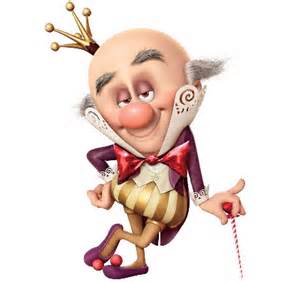 There are many good messages in this film—the importance of love for others, community is needed, identity and purpose in life are essential. But I found one message in particular that stood out above the rest. Once Ralph enters Sugar Rush, a Candyland-ish kart-racing game, my ears perked up. As the full story goes as told by Felix, Turbo, a character from another, older ‘classic’ game called Turbo Time, abandoned his arcade game and jumped into another game, Road Blasters, when it became more popular than his own game. Turbo tried to take over the new game, but he was sabotaging it. In the end, he put both games ‘Out of Order’ forever.
There are many good messages in this film—the importance of love for others, community is needed, identity and purpose in life are essential. But I found one message in particular that stood out above the rest. Once Ralph enters Sugar Rush, a Candyland-ish kart-racing game, my ears perked up. As the full story goes as told by Felix, Turbo, a character from another, older ‘classic’ game called Turbo Time, abandoned his arcade game and jumped into another game, Road Blasters, when it became more popular than his own game. Turbo tried to take over the new game, but he was sabotaging it. In the end, he put both games ‘Out of Order’ forever.
We come to find out that Turbo has jumped games again. And the phrase was coined ‘going turbo.’ Desiring to be the star of a popular game, Turbo hacked Sugar Rush so that no one would remember their original programming. Turbo destroyed the original design, the original programming for the game and he re-made himself into King Candy, the star and ruler of the place. It is now a corrupted game, a fallen world under the power of a Deceiver who doesn’t belong in that world. Turbo disguises himself as a sweet and benevolent ruler, King Candy, but he is really an evil liar.
Turbo becomes the real villain in the movie, bent on world domination—as so many are. And if you haven’t caught it yet, Turbo/King Candy is a Satan-like character who rules a now-corrupted game that is not as it is supposed to be. And the corruption extends to its citizens. For example, King Candy has corrupted Vanellope’s character by trying to totally delete her code– to the point that she glitches. She used to be a racer. And Vanellope is ostracized from her community for glitching, treated badly by the other racers, and prevented from entering the daily race.
After making a deal with Vanellope to win back his medal by winning the next day’s race, Ralph uses his wrecking ability at Kart Bakery where karts are created to help build Vanellope a kart race car. This is the first time we see him using his abilities for good—to create something rather than destroy something.
While Vanellope is gone, King Candy approaches Ralph and offers to give him back his medal if Ralph prevents Vanellope from racing. And at first we see King Candy as a good and kind leader who prevents ‘the glitch’ from racing for reasons of safety—hers and the other racers. As King Candy explains it to Ralph, Vanellope can’t be allowed to race, because if she were to win she would be added to the race roster and arcade gamers could chose her as their avatar. Then they would see her glitching and they would think the game is broken and it would be labeled ‘Out of Order’ and eventually unplugged. All the characters would become homeless, but Vanellope would be killed, because she can’t leave the game.
King Candy corrupts Ralph by tricking him into thinking that Vanellope shouldn’t race. Ralph, doing what Ralph does best, wrecks the kart to protect her. And Ralph returns to his game with his medal. Only to find it abandoned and given the death sentence label of ‘Out of Order.’ Ralph realizes that the object of his desire wasn’t really what he wanted. And he throws the medal away. Ralph, from his game, sees Vanellope’s picture on the outside console of her game. He realizes that she used to be a racer. Ralph returns to Sugar Rush and he learns that if Vanellope crosses the finish line the game will reset to its original programming and she won’t be a glitch anymore.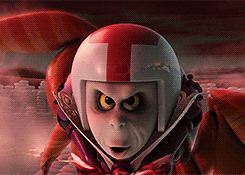
Felix, imprisoned by King Candy, bemoans the fact that he is a fixer rather than a wrecker. Ralph once again is able to use his programmed role as a wrecker for good when he wrecks Felix out of prison. And Felix uses his ability as a fixer to fix Vanellope’s race kart. Vanellope joins the race underway, while at the same time the cy-bug—who has now turned into a cy-bug army—overruns the game.
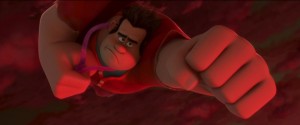 Meanwhile, Vanellope glitches purposefully to pull ahead of King Candy in the race. Ralph, to save Vanellope, sacrifices himself and wrecks the mentos into the cola hot springs to create a beacon that the cy-bugs will be drawn to and killed in. In doing so, he not only saves Vanellope, but also saves her world from the cy-bugs that he had unintentionally introduced. Ralph finds redemption. In Sugar Rush Ralph shows his hero side. He ultimately was willing to sacrifice himself to save Vanellope and her world. And that is what a hero does. In any world, it is behavior and actions that define who we are—our identity—and if we will be labeled a villain or a hero.
Meanwhile, Vanellope glitches purposefully to pull ahead of King Candy in the race. Ralph, to save Vanellope, sacrifices himself and wrecks the mentos into the cola hot springs to create a beacon that the cy-bugs will be drawn to and killed in. In doing so, he not only saves Vanellope, but also saves her world from the cy-bugs that he had unintentionally introduced. Ralph finds redemption. In Sugar Rush Ralph shows his hero side. He ultimately was willing to sacrifice himself to save Vanellope and her world. And that is what a hero does. In any world, it is behavior and actions that define who we are—our identity—and if we will be labeled a villain or a hero.
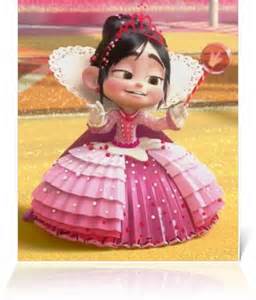 And Vanellope in turn rescues Ralph using her racing ability and glitching. Vanellope crosses the finish line, restoring her world. She is transformed into Princess Vanellope, “the rightful ruler,” because, after all, this is a Disney movie– a princess is a requirement. All the citizens’ memories are restored. And King Candy/Turbo, who has turned into a cy-bug hybrid, is justly killed when he goes into the beacon’s light and is zapped—following his new programming.
And Vanellope in turn rescues Ralph using her racing ability and glitching. Vanellope crosses the finish line, restoring her world. She is transformed into Princess Vanellope, “the rightful ruler,” because, after all, this is a Disney movie– a princess is a requirement. All the citizens’ memories are restored. And King Candy/Turbo, who has turned into a cy-bug hybrid, is justly killed when he goes into the beacon’s light and is zapped—following his new programming.
[amazon asin=B00A83075M&template=iframe imageright]
In the end, Ralph returns to his role as the wrecker in his game—fulfilling the role he was created for—as ‘the favorite bad guy.’ But after hours, he is accepted, loved, and happy with Felix and the Nicelanders.
Wreck-It Ralph is a movie about identities and roles, good and evil actions, heroes and villains. But most importantly, the movie follows the Creation-Fall-Redemption-Restoration story arc of Christianity. And it helps us, by comparison, understand and applaud such a story.
